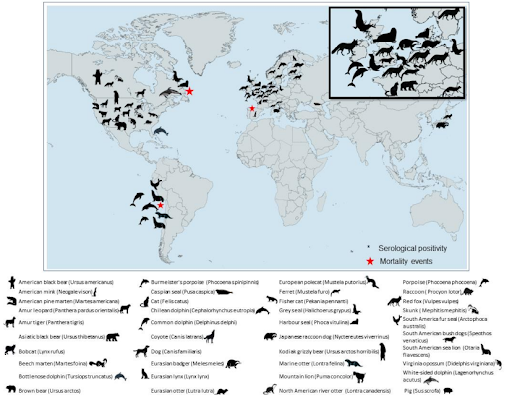
#17,513
While we await further word from Polish authorities on the recent spate of feline deaths from H5N1 (see Poland Vet. Chief: H5N1 Confirmed In Dead Cats Across Several Regions), it seems an opportune time to review the history of cats and avian influenza.
Up until 2 decades ago, cats (and dogs) were thought largely immune to influenza A infection.
28 February 2006
(EXCERPTS)
Several published studies have demonstrated H5N1 infection in large cats kept in captivity. In December 2003, two tigers and two leopards, fed on fresh chicken carcasses, died unexpectedly at a zoo in Thailand. Subsequent investigation identified H5N1 in tissue samples.
In February 2004, the virus was detected in a clouded leopard that died at a zoo near Bangkok. A white tiger died from infection with the virus at the same zoo in March 2004.
In October 2004, captive tigers fed on fresh chicken carcasses began dying in large numbers at a zoo in Thailand. Altogether 147 tigers out of 441 died of infection or were euthanized. Subsequent investigation determined that at least some tiger-to-tiger transmission of the virus occurred.
In 2006, Dr. C.A. Nidom demonstrated that of 500 cats he tested in and around Jakarta, 20% had antibodies for the bird flu virus. In 2007 the FAO warned that: Avian influenza in cats should be closely monitored, and in 2012 the OIE reported on Cats Infected With H5N1 in Israel, although so far no sustained virus transmission in cats or from cats to humans has been observed.
Greater virulence of highly pathogenic H5N1 influenza virus in cats than in dogs.
Kim HM1, Park EH, Yum J, Kim HS, Seo SH.
Abstract
Highly pathogenic H5N1 influenza virus continues to infect animals and humans. We compared the infectivity and pathogenesis of H5N1 virus in domestic cats and dogs to find out which animal is more susceptible to H5N1 influenza virus. When cats and dogs were infected with the H5N1 virus, cats suffered from severe outcomes including death, whereas dogs did not show any mortality.
Perhaps the biggest wake up call came in late 2016 when we saw an avian H7N2 virus sweep through hundreds of cats housed at multiple New York Animal shelters - while also infecting at least two people - demonstrating that that cats can become efficient transmitters of a novel flu virus as well.
In 2020 we looked at a research article, published in the Journal of Clinical Microbiology, that examined the seroprevalence of influenza A in both dogs and cats from shelters and homes in the Netherlands.
While it is not surprising that evidence of past 2009 H1N1 infection was found in both dogs and cats, researchers also found evidence of avian H5, H7, and H9 virus exposure in cats and dogs (see chart below).
While only rarely reported, the evidence suggests these types of infections are more common than we know.
Although there is still much we don't know about the outbreak in cats in Poland, this appears to be one of the largest, and most widespread, outbreaks in domestic cats on record.
For now, officials are urging people in Poland keep their cats indoors. Our own CDC has guidance (published before this latest outbreak), which you can access at:
https://www.cdc.gov/flu/avianflu/avian-in-other-animals.htm
If your domestic animals (e.g., cats or dogs) go outside and could potentially eat or be exposed to sick or dead birds infected with bird flu viruses, or an environment contaminated with bird flu virus, they could become infected with bird flu. While it’s unlikely that you would get sick with bird flu through direct contact with your infected pet, it is possible. For example, in 2016, the spread of bird flu from a cat to a person was reported in NYC. The person who was infected [2.29 MB, 4 pages] was a veterinarian who had mild flu symptoms after prolonged exposure to sick cats without using personal protective equipment.
If your pet is showing signs of illness compatible with bird flu virus infection and has been exposed to infected (sick or dead) wild birds/poultry, you should monitor your health for signs of fever or infection.
Take precautions to prevent the spread of bird flu.
As a general precaution, people should avoid direct contact with wild birds and observe wild birds only from a distance, whenever possible. People should also avoid contact between their pets (e.g., pet birds, dogs and cats) with wild birds. Don’t touch sick or dead birds, their feces or litter, or any surface or water source (e.g., ponds, waterers, buckets, pans, troughs) that might be contaminated with their saliva, feces, or any other bodily fluids without wearing personal protective equipment (PPE).
More information about specific precautions to take for preventing the spread of bird flu viruses between animals and people is available at Prevention and Antiviral Treatment of Bird Flu Viruses in People. Additional information about the appropriate PPE to wear is available at Backyard Flock Owners: Take Steps to Protect Yourself from Avian Influenza.
While Poland's outbreak in cats will hopefully end up being short-lived, it is a reminder that H5N1 continues to surprise, and should not be underestimated.

